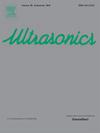Ni80Fe20纳米点阵列修饰Si/SiO2体系中高频Sezawa模式的光激发与检测。
IF 3.8
2区 物理与天体物理
Q1 ACOUSTICS
引用次数: 0
摘要
表面声波已成为发展下一代基于波的信息和计算技术的潜在候选者之一。对于实际设备而言,开发不同类型表面声波的激励技术,特别是在较高的微波频率下,并调整其频率与波矢量特性是至关重要的。我们表明,这可以通过使用超短激光脉冲入射到金属纳米点周期性阵列装饰的多层表面来实现。具体地说,我们研究了用Ni80Fe20 (Py)薄点阵装饰的介电衬底Si/SiO2中的表面声波。利用飞秒激光光泵浦探针测量,我们检测到一些高频声子模式。通过进行有限元模拟,我们将它们识别为来自第二和第三布里渊区的Sezawa模态,以及局限在Py点内的模态。Sezawa模式的频率强烈依赖于Py点的周期,并在5至15 GHz的范围内变化。对于周期小于400nm的Py点,两种类型的波覆盖相同的频率范围,为磁弹性研究提供了一个有前途的系统。本文章由计算机程序翻译,如有差异,请以英文原文为准。
Optical excitation and detection of high-frequency Sezawa modes in Si/SiO2 system decorated with Ni80Fe20 nanodot arrays
Surface acoustic waves have emerged as one of the potential candidates for the development of next-generation wave-based information and computing technologies. For practical devices, it is essential to develop the excitation techniques for different types of surface acoustic waves, especially at higher microwave frequencies, and to tailor their frequency versus wave vector characteristics. We show that this can be done by using ultrashort laser pulses incident on the surface of a multilayer decorated with a periodic array of metallic nanodots. Specifically, we study surface acoustic waves in the dielectric substrate Si/SiO2 decorated with a square lattice of thin Ni80Fe20 (Py) dots. Using a femtosecond laser-based optical pump–probe measurement, we detect a number of high-frequency phononic modes. By performing finite element simulations, we identify them as Sezawa modes from the second and third Brillouin zone in addition to the modes confined within the Py dots. The frequency of the Sezawa modes strongly depends on the period of the Py dots and varies in the range between 5 to 15 GHz. Both types of waves cover the same frequency range for Py dots with period less than 400 nm, providing a promising system for magnetoelastic studies.
求助全文
通过发布文献求助,成功后即可免费获取论文全文。
去求助
来源期刊

Ultrasonics
医学-核医学
CiteScore
7.60
自引率
19.00%
发文量
186
审稿时长
3.9 months
期刊介绍:
Ultrasonics is the only internationally established journal which covers the entire field of ultrasound research and technology and all its many applications. Ultrasonics contains a variety of sections to keep readers fully informed and up-to-date on the whole spectrum of research and development throughout the world. Ultrasonics publishes papers of exceptional quality and of relevance to both academia and industry. Manuscripts in which ultrasonics is a central issue and not simply an incidental tool or minor issue, are welcomed.
As well as top quality original research papers and review articles by world renowned experts, Ultrasonics also regularly features short communications, a calendar of forthcoming events and special issues dedicated to topical subjects.
 求助内容:
求助内容: 应助结果提醒方式:
应助结果提醒方式:


